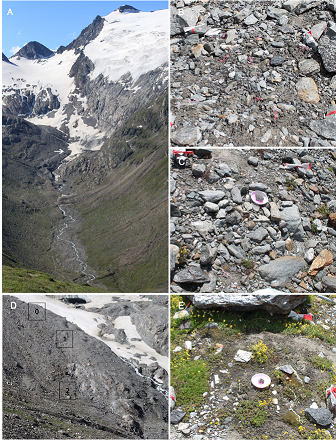Projekte
MICINSNOW – Microbial Interactions in Snow-Covered Habitats

Snow-covered landscapes suggest an image of dormancy and hibernation. However, underneath the snow cover soil is teeming with microbial activity. The project “MICINSNOW - Microbial Interactions in Snow Covered Habitats” investigates winter-active soil microbial communities (MCs) and their interactions.
MCs are investigated at three different habitat types, ranging from recently de-glaciated bare-soil in the glacier forefield, over alpine dwarf shrub communities with about 150 years of soil development, to a Swiss stone pine forest with a distinct humus layer. The hypotheses to test are: 1) Snow-covered soil harbours typical winter MCs. 2) There are typical associations between winter-active fungi and prokaryotic microorganisms (bacteria, archaea), which co-occur due to mutual dependencies. 3) Fungi dominate winter-active MCs and a large proportion of them are currently unknown.
To test these hypotheses, the total of microbial organisms is captured by massive parallel sequencing of soil DNA and RNA, which enables us to simultaneously get information about the identity and activity of the present soil microorganisms. Bioinformatics and statistical analyses deliver first conclusions on microbial interactions, which will be tested in a second step by visual methods (FISH: fluorescence in situ hybridization). To selectively isolate winter-active fungi by a cultivation-dependent approach, in-growth mesh bags filled with sterile quartz sand are buried in the soil. Fungi that are active during the time of burial will grow through the bags and leave biomass on the quartz sand. Fungal isolates can then be obtained by incubation of sand grains on nutrient media. Pure cultures are classified based on morphological characteristics and unambiguously identified by marker genes.

Previously unknown isolates are characterized with comparative morphological, physiological, and phylogenetic methods and described as new species. All isolates will be deposited in public microbial culture collections and thus made available to the scientific community for further studies (e.g. screening for cold-adapted enzymes). What makes this project particularly innovative and valuable is that interactions of active soil MCs are investigated based on a combination of cultivation and culture-independent molecular methods, as well as visual methods and modern bioinformatics tools. The knowledge on typical interactions between microorganisms provides insights in the potential role of microbial associations in cold soil, and sets the stage for further experimental studies on the function of fungi and prokaryotic organisms in snow-covered soils.
Duration
2020-2025
Project Partners
Dr. Beat Frey, Eidgenössische Forschungsanstalt für Wald, Schnee und Landschaft (WSL) Brimersdorf (CH)
Dr. Benedetta Turchetti, Ciro Sannino, Pietro Buzzini, Microbiology research Unit of the Department of Agricultural, Food and Environmental Sciences of the University of Perugia (Italy)
Dr. Franco Biasioli, Dr. Iuliia Khomenko, Edmund Mach Foundation, San Michele all` Adige (Italy)
Dr. Bianka Siewert, Institute Pharmacy/Pharmacognosy, University of Innsbruck
Publications
Mandolini, E., Bacher, M., Peintner, U. (2022) Ectomycorrhizal fungal communities of Swiss stone pine (Pinus cembra) depend on climate and tree age in natural forests of the Alps. Plant and Soil https://doi.org/10.1007/s11104-022-05497-z
Telagathoti, A., Probst, M., Mandolini, E., Peintner, U. (2022) Mortierellaceae from subalpine and alpine habitats: new species of Entomortierella, Linnemannia, Mortierella, Podila and Tyroliella gen. nov. Studies in Mycology 103: 25-5 https//: doi: 10.3114/sim.2022.103.02
Mandolini, E., Probst, M., & Peintner, U. (2021). Methods for Studying Bacterial–Fungal Interactions in the Microenvironments of Soil. Applied Sciences, 11(19), 9182. https://doi.org/10.3390/app11199182
Telagathoti, A., Probst, M., Khomenko, I., Biasioli, F., & Peintner, U. (2021). High-Throughput Volatilome Fingerprint Using PTR–ToF–MS Shows Species-Specific Patterns in Mortierella and Closely Related Genera. Journal of Fungi, 7(1), 66. https://doi.org/10.3390/jof7010066
Telagathoti, A., Probst, M., & Peintner, U. (2021). Habitat, snow-cover and soil pH, affect the distribution and diversity of mortierellaceae species and their associations to bacteria. Frontiers in microbiology, 12. https://doi.org/10.3389/fmicb.2021.669784
Boonmee, S., Wanasinghe, D. N., Calabon, M. S., Huanraluek, N., Chandrasiri, S. K., Jones, G. E., ... & Hyde, K. D. (2021). Fungal diversity notes 1387–1511: Taxonomic and phylogenetic contributions on genera and species of fungal taxa. Fungal Diversity, 111(1), 1-335. https://doi.org/10.1007/s13225-021-00489-3
Dresch, P., Falbesoner, J., Ennemoser, C., Hittorf, M., Kuhnert, R., & Peintner, U. (2019). Emerging from the ice‐fungal communities are diverse and dynamic in earliest soil developmental stages of a receding glacier. Environmental Microbiology, 21(5), 1864-1880. https://doi.org/10.1111/1462-2920.14598
